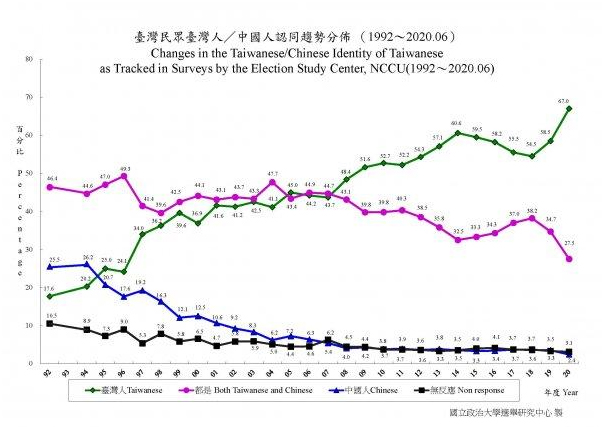
Chinese Belligerence Increases the Number of People Identifying as Taiwanese
Published 21st July 2020 by Evan Tsao under International Strategic Studies

Chinese Belligerence Increases the Number of People Identifying as Taiwanese
Introduction
National Election Study Center at National Chengchi University released a Taiwanese/Chinese identity survey on July 3, 2020.1 This survey illustrates the longitudinal identity change in 3 main categories- Taiwanese, Chinese, and both. The result shows 67% of the people on the island identify themselves as exclusively Taiwanese marking the highest level since 1992 (46.4%).2 The outcome coincides with a study conducted by Pew Research earlier last year (68%). 3
Table 1: Changes in Taiwanese/Chinese Identity of Taiwanese (1992- June 2020)4

Provocative China
The unprecedented number clearly shows China’s unilateral approach to unify Taiwan has been counterproductive because of the increase in the identification of population as Taiwanese. In 2018, when President Tsai was suffering from low satisfaction poll results due to domestic reforms, only 54.5% of people identified themselves as Taiwanese.5 However, the number soared up to 58.5% no long after Xi Jinping gave his January 2 speech to commemorate the 40th year anniversary of “Message to Compatriots in Taiwan” in 2019. Xi unilaterally declared “One Country Two Systems” by putting an end to the previously agreed upon “1992 Consensus”, an under-table political arrangement to allow both sides to have their own interpretation on “One China” to create space for cross-strait economic cooperation. The announcement was a sign of China’s true intention to lock Taiwan’s future into its ruling just as it did with Hong Kong.
History shows that China’s military threats to Taiwan only reinforces Taiwanese identity. In July 1995, China launched a series of military drills in response to Taiwan president Lee Teng Huei’s visit to his alma mater Cornell University in June. To follow through its tactics, China fired missiles into Taiwan’s territorial waters in March 1996 when Taiwan was about to hold its first direct presidential election.6 After the crisis, Taiwanese identity boosted from 25% in 1995 to 34% in 1997.7
Currently, in 2019-20, as China has once again tried to grasp the opportunity of the COVID-19 pandemic to shift the public’s focus away from its domestic political problems (such as Hong Kong), and gain more leverage over the US (including the trade deal),8 it went back to undermine Taiwan’s security. From January to the end of June 2020 alone, Peoples’ Liberation Army’s aircraft and ships harassed Taiwan’s Air Defense Identification Zone (ADIZ) and near waters at least 20 times (until July 2020).9 This is significantly higher than the incidences of 2019 in total (18 times).10 As pointed out already, such belligerence from China has only bolstered the Taiwanese identity which, as per the numbers has skyrocketed to 67%, the highest in history.11 Interestingly, those who consider themselves as both Chinese and Taiwanese dropped to 27.5 percent, the lowest point in history by contrast.12
Hedging Voter Identities
Aside from China’s failed unification policy, there is a natural hedging tendency among Taiwanese voters as well. For example, when President Lee proposed his “two-state” theory in 1999, Taiwanese identity figures declined from 39.6% (1999) to 36.9% (2000). From 2008 to 2014, when President Ma Ying Jeou sought to further economic ties with China,13 Taiwanese identity soared from 44.7%(2014) to 60.6%(2017).14
After the 2008 financial crisis, Taiwan was looking for regional integration with other countries such as Japan and those in the ASEAN region. However, China blocked these efforts and forced Taiwan to integrate its economy with China on an increased level.15 Interestingly, the outbreak of the Sunflower Movement which urged the Ma government to halt the cross-strait Economic Framework Agreement (ECFA) in 2014,16 Taiwanese identity gradually declined from 60.6% (2014) to 54.5% (2018).17 These selected events are all negatively correlated with the percentage of dual identity. However, the voters' adversarial identity preference did not stop the overall growing trend of Taiwanese identity.
Conclusion
Perhaps one can reasonably expect China to increase its provocative actions in response to the increased assertion of Taiwanese identity. However, the Taiwanese identity is on the upswing as a general trend and this needs to be taken into account as a geopolitical reality. Its implication for Beijing is a clear message that an increase in assertion is only going to strengthen Taiwan.
Reference
- 1. National Election Study Center at National Chengchi University. "Taiwanese / Chinese Identity(1992/06~2020/06)." National Election Study Center. Last modified July 3, 2020. Accessed July 18,2020. https://esc.nccu.edu.tw/course/news.php?Sn=166.
- 2. ibid.
- 3. Devlin, Kat, and Christine Huang. "In Taiwan, Views of Mainland China Mostly Negative." Pew Research Center. Last modified May 12, 2020. Accessed July 18, 2020. https://www.pewresearch.org/global/2020/05/12/in-taiwan-views-of-mainland-china-mostly-negative/.
- 4. National Election Study Center at National Chengchi University. "Taiwanese / Chinese Identity(1992/06~2020/06)." National Election Study Center. Last modified July 3, 2020. Accessed July 18,2020. https://esc.nccu.edu.tw/course/news.php?Sn=166.
- 5. ibid.
- 6. Bosco, Joseph A. "The 1995-96 Taiwan Strait Crisis: Three What Ifs?" Asia Research Institute at University of Nottingham. Last modified January 26, 2019. Accessed July 20, 2020. https://theasiadialogue.com/2019/01/26/the-1995-96-taiwan-strait-crisis-three-what-ifs/.
- 7. National Election Study Center at National Chengchi University. "Taiwanese / Chinese Identity(1992/06~2020/06)." National Election Study Center. Last modified July 3, 2020. Accessed July 18,2020. https://esc.nccu.edu.tw/course/news.php?Sn=166.
- 8. Randolph, Sean. "As coronavirus strains US-China relations, ensuring 'phase one' trade deal works is crucial." South China Morning Post, July 8, 2020. Accessed July 20, 2020. https://www.scmp.com/comment/opinion/article/3092094/coronavirus-strains-us-china-relations-ensuring-phase-one-trade.
- 9. Ministry of National Defense R.O.C. "Press Releases." Defense News. Accessed July 20, 2020. https://www.mnd.gov.tw/English/PublishTable.aspx?types=Defense%20News&Title=News%20Channel.
- 10. ibid.
- 11. National Election Study Center at National Chengchi University. "Taiwanese / Chinese Identity(1992/06~2020/06)." National Election Study Center. Last modified July 3, 2020. Accessed July 18,2020. https://esc.nccu.edu.tw/course/news.php?Sn=166.
- 12. ibid.
- 13. Yasuhiro, Matsuda (2015) Cross-Strait Relations under the Ma Ying-jeou administration: From Economic to Political Dependence?, Journal of Contemporary East Asia Studies, 4:2, 3-35, DOI: 10.1080/24761028.2015.11869083
- 14. National Election Study Center at National Chengchi University. "Taiwanese / Chinese Identity(1992/06~2020/06)." National Election Study Center. Last modified July 3, 2020. Accessed July 18,2020. https://esc.nccu.edu.tw/course/news.php?Sn=166.
- 15. Guo, Jiann-jong. "亞太區域經濟組織發展與台灣的選擇" [Regional Economic Agreements in Asia Pacific and ways out for Taiwan]. Taiwan International Studies Quarterly 1, no. 4 (Winter 2005): 2. Accessed July 21, 2020. http://www.tisanet.org/quarterly/1-4-2.pdf.
- 16. Liu, T.-t., & Tsai, T.-c. (2017). Cross-Strait Relations and Regional Integration: A Review of the Ma Ying-jeou Era (2008-2016). Journal of Current Chinese Affairs, 46(1), 11-35. https://nbn-resolving.org/urn:nbn:de:gbv:18-4-10403
- 17. National Election Study Center at National Chengchi University. "Taiwanese / Chinese Identity(1992/06~2020/06)." National Election Study Center. Last modified July 3, 2020. Accessed July 18,2020. https://esc.nccu.edu.tw/course/news.php?Sn=166.

Evan Tsao
Evan is a master’s candidate at the Fletcher School of Law and Diplomacy with a focus on US foreign policy and Pacific Asia studies. He was an assistant research fellow at a Taiwanese premier foreign policy think-tank Prospect Foundation, where he coordinated track 2 diplomacy events and conducted policy analyses. He was also a Project Associate at a multinational public relations firm and an intern at the EU Embassy in Taiwan. He is particularly interested in US-China-Taiwan relations, US congress, the Indo-Pacific strategy, and the Belt and Road Initiative. Currently, he is also a Research Associate at Global Policy Insights.
Recent Articles
- Models of Public Service Delivery for the Homeless in India: A Comparative Analysis and an Agenda for the Future
- Discussion with H.E. Ambassador Christoph Heusgen
- Round Table Discussion with H.E. Ms. Louise Blais
- China-Iran Deal: A Checkmate to India
- Chinese Belligerence Increases the Number of People Identifying as Taiwanese
- Interview with Sylvia Mishra on India's Defense Relations with Major Powers in the Post- COVID-19 World
- Peering into the future - Economy, Society amd World Politics after COVID-19
- Humanity better off with world order without ‘Chinese characteristics’
- Military Recruitment in the U.S., China, and Russia
- A Comparative Analysis of Key Structures & Responses to the Syrian Refugee Crisis in Germany, Turkey, and the United States
- Analysing the Abrogation of Article 370
- Rethinking India’s Strategic Choices for National Security
- Global Policycast: Geopolitics and Economic changes in Ukraine & Eastern Europe, Christina Pushaw (expert on Eastern European Affairs) in conversation with Arpit Chaturvedi (CEO, Global Policy Insights)
- Syria in ruins as war enters 9th year
- Lord Howell of Guildford’s key note speech at Global policy insight’s seminar on Post Brexit World: UK and the Commonwealth
- A Post - Brexit Britain & India Partnership can Unlock the Potential of the Commonwealth
- Lessons from the Great War : Inevitability versus Institutions
- UK-India Trade Relations: The Long Road Ahead
